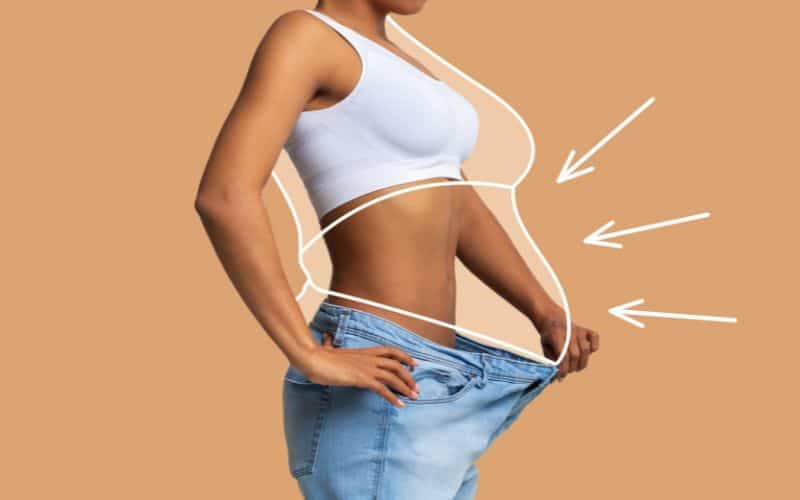Losing weight can be a challenging task, especially when you have a specific goal in mind, like going down a dress or pant size. However, it is not always easy to determine how much weight you need to lose to achieve your desired size. While there is no one-size-fits-all answer, there are some general guidelines you can follow to help you on your weight loss journey.
According to experts, losing one to two pounds per week is considered a safe and sustainable pace. However, the amount of weight you need to lose to drop a size can vary based on your starting weight, body composition, and other factors. For example, someone who weighs 350 pounds may still wear the same clothing after losing 10 pounds, whereas a 100-pound person who loses 10 pounds may drop a size. It is important to keep in mind that the ratio of weight lost also matters when it comes to dropping a size.
Contents
Understanding Weight Loss

Losing weight is a complex process that involves many factors, including genetics, lifestyle, and diet. While there is no one-size-fits-all answer to how much weight you need to lose to go down a size in clothing, there are some general guidelines that can help you understand the process.
Firstly, it's important to note that weight loss is not always linear. Some people may lose weight quickly at first, while others may experience a plateau or even gain weight before seeing results. This is because weight loss is influenced by many factors, including hormonal changes, stress, and sleep patterns.
In general, losing 5-10% of your body weight can lead to noticeable changes in your clothing size. For example, if you weigh 200 pounds and lose 10-20 pounds, you may be able to drop a size. However, it's important to remember that everyone's body is different, and weight loss can be influenced by many factors.
Another important factor to consider is where you lose weight from. Losing weight from your midsection can have a greater impact on your clothing size than losing weight from your arms or legs. This is because the waist and hips are key areas where clothing sizes are determined.
In addition to weight loss, other factors can also impact your clothing size, including muscle mass and body composition. Building muscle through strength training can help you look leaner and more toned, even if you don't lose weight. On the other hand, losing weight without building muscle can lead to a "skinny fat" appearance, where you may still have excess body fat despite a smaller clothing size.
Overall, understanding weight loss and how it impacts your clothing size can be a helpful tool in achieving your health and fitness goals. By focusing on sustainable lifestyle changes, including regular exercise and a healthy diet, you can create long-term changes that lead to a healthier, happier you.
Determining Your Clothing Size

Knowing your clothing size is important when trying to determine how much weight you need to lose to go down a size. However, clothing sizes can vary between brands and even between different styles from the same brand. Therefore, it's important to take accurate measurements of your body to determine your clothing size.
To measure your body, use a flexible measuring tape and measure the following areas:
- Bust: Measure around the fullest part of your bust, making sure the tape is level across your back.
- Waist: Measure around the narrowest part of your waist, usually about one inch above your belly button.
- Hips: Measure around the fullest part of your hips, usually about eight inches below your waist.
Once you have your measurements, compare them to the size chart provided by the brand you're interested in purchasing from. If your measurements fall between two sizes, it's usually best to go with the larger size.
It's important to note that clothing sizes can vary between brands, so it's always a good idea to try on clothing before purchasing it to ensure the best fit. Additionally, some clothing styles may fit differently than others, so it's important to consider the style of clothing you're interested in when determining your size.
Overall, taking accurate measurements of your body and comparing them to size charts can help you determine your clothing size and make it easier to determine how much weight you need to lose to go down a size.
The Correlation Between Weight and Clothing Size

When it comes to weight loss, many people wonder how much weight they need to lose to go down a clothing size. Unfortunately, there is no one-size-fits-all answer to this question, as several factors can affect clothing size beyond weight alone.
Factors Affecting Clothing Size
While weight is certainly a significant factor in determining clothing size, it is not the only one. Other factors that can affect clothing size include:
- Body shape: Different body shapes can carry weight differently, which can affect how much weight you need to lose to go down a clothing size.
- Muscle mass: Muscle weighs more than fat, so someone who is very muscular may weigh more but wear a smaller clothing size than someone who is less muscular.
- Clothing brand: Clothing brands can have different sizing standards, so a size 10 in one brand may be a size 12 in another.
Typical Weight Loss for Size Reduction
While weight loss alone may not be the only factor in determining clothing size, it is still an important one. According to Livestrong, experts recommend losing weight at a safe and sustainable pace of 1 to 2 pounds per week. This can translate to dropping a clothing size in as little as 10 pounds of weight loss, depending on factors such as body shape and muscle mass.
It's also worth noting that weight loss does not always correspond directly to clothing size reduction. Someone who loses inches but not necessarily pounds may still go down a clothing size, as they are losing body fat and gaining muscle mass. Therefore, it's important to focus on overall health and body composition rather than just the number on the scale when working towards clothing size reduction.
Overall, while weight loss is an important factor in determining clothing size, it is not the only one. Body shape, muscle mass, and clothing brand can all affect clothing size beyond weight alone. However, losing weight at a safe and sustainable pace of 1 to 2 pounds per week can often lead to dropping a clothing size in as little as 10 pounds of weight loss.
Healthy Weight Loss Strategies

Losing weight can be a challenging process, but it is achievable with the right strategies. Healthy weight loss involves making lifestyle changes that can be sustained over time. In this section, we will discuss two key strategies for healthy weight loss: dietary changes and physical activities.
Dietary Changes
Dietary changes are an essential part of healthy weight loss. Here are some effective dietary strategies to help you lose weight:
- Reduce calorie intake: To lose weight, you need to create a calorie deficit. This means that you need to consume fewer calories than you burn. You can achieve this by reducing your calorie intake. Aim to reduce your daily calorie intake by 500 to 1000 calories.
- Choose healthy foods: Focus on eating nutrient-dense, whole foods such as fruits, vegetables, whole grains, lean proteins, and healthy fats. These foods will provide you with the nutrients you need while also keeping you full and satisfied.
- Control portion sizes: Portion sizes can significantly impact your calorie intake. Use smaller plates and bowls to help control your portion sizes.
- Avoid processed foods: Processed foods are often high in calories, unhealthy fats, and added sugars. They can also be low in nutrients. Avoid processed foods as much as possible.
Physical Activities
Physical activities are also essential for healthy weight loss. Here are some effective physical activity strategies to help you lose weight:
- Increase daily activity: Aim to increase your daily activity level. Take the stairs instead of the elevator, walk instead of driving, and stand instead of sitting whenever possible.
- Engage in regular exercise: Regular exercise can help you burn calories and build muscle. Aim to engage in at least 150 minutes of moderate-intensity exercise or 75 minutes of vigorous-intensity exercise each week.
- Incorporate strength training: Strength training can help you build muscle, which can increase your metabolism and help you burn more calories. Aim to incorporate strength training exercises into your routine at least two times per week.
By making these dietary and physical activity changes, you can achieve healthy weight loss. Remember to consult with a healthcare professional before starting any weight loss program.
Setting Realistic Goals
When it comes to weight loss, setting realistic goals is crucial to success. Losing weight to go down a size can be a great motivator, but it's important to set achievable goals that won't leave you feeling discouraged or overwhelmed. Here are some tips for setting realistic goals:
Understand How Much Weight You Need to Lose
The amount of weight you need to lose to go down a size will depend on a variety of factors, including your current weight, body shape, and the size you want to reach. In general, losing 5-10% of your body weight can result in a noticeable change in clothing size. For example, if you weigh 200 pounds, losing 10-20 pounds could help you go down a size.
Set a Realistic Timeframe
Losing weight too quickly can be unhealthy and unsustainable. Aim to lose 1-2 pounds per week, which is a safe and realistic rate of weight loss. This means that if you need to lose 10 pounds to go down a size, it may take you 5-10 weeks to achieve this goal.
Focus on Healthy Habits
Rather than solely focusing on the number on the scale, aim to adopt healthy habits that will support your weight loss goals. This may include incorporating more fruits and vegetables into your diet, drinking plenty of water, and getting regular exercise. By focusing on healthy habits, you'll not only be more likely to achieve your weight loss goals, but you'll also be improving your overall health and well-being.
Celebrate Small Victories
Losing weight can be a long and challenging journey, so it's important to celebrate small victories along the way. Whether it's fitting into a pair of jeans that were previously too tight or hitting a fitness milestone, take time to acknowledge and celebrate your progress. This can help keep you motivated and on track towards your ultimate goal of going down a size.
Conclusion
Losing weight to go down a size can be a challenging task. However, it is important to remember that the amount of weight loss required to go down a size can vary based on several factors, such as body type, muscle mass, and bone structure.
Based on the search results, it is difficult to determine the exact amount of weight loss required to go down a size. However, losing 10-15 pounds may result in going down a size for some individuals. It is important to remember that losing weight in a healthy and sustainable way is more important than fitting into a certain size.
Maintaining a healthy weight requires long-term commitment and lifestyle changes. Strategies for successful weight loss include making a commitment, setting realistic goals, monitoring progress, and seeking support. It is also important to make permanent changes to eating and activity habits, rather than relying on fad diets or extreme measures.
In conclusion, while weight loss can result in going down a size, it should not be the sole focus. The most important goal should be achieving and maintaining a healthy weight through sustainable lifestyle changes.






